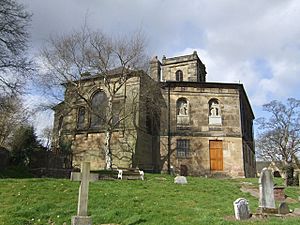St Michael's Church, Madeley facts for kids
Quick facts for kids St Michael's Church, Madeley |
|
|---|---|
 |
|
| 52°38′1.4″N 2°27′0.9″W / 52.633722°N 2.450250°W | |
| Location | Madeley, Shropshire |
| Country | England |
| Denomination | Church of England |
| Website | http://www.tf7.org.uk/stmichaels/ |
| History | |
| Dedication | St. Michael |
| Administration | |
| Parish | Madeley |
| Diocese | Diocese of Hereford |
St Michael's Church in Madeley, England, is a special church. It's one of three churches that make up the Madeley Parish, which is part of the Church of England. You can find it near the center of Madeley, Shropshire.
A Look Back in Time
St Michael's Church was designed by a famous engineer named Thomas Telford. It was built in 1796. This new church replaced an even older one. One of the important leaders of the old church was John William Fletcher. You can still see his special iron tombstone in the churchyard today.
Church Design
St Michael's Church has a unique shape. It's built like an octagon, which means it has eight sides. It also has a square tower that reaches up towards the sky.
Remembering Heroes
Inside the church, there are several special plaques and panels. These are called war memorials. They help us remember people from the area who bravely served and lost their lives in wars.
- At the west end, there are two carved wooden panels. They have brass plaques below them. These plaques list the names of people from the parish who died in World War I. The panels also show figures of saints like St Luke, St Maurice, St George, St Michael, St Joan of Arc, and St Barbara.
- Another stone plaque, moved from a closed church, lists men from the Aqueduct area who died in both World Wars.
- On the north wall, a marble plaque remembers men from Madeley parish who died in World War I.
- There are also plaques for specific soldiers. One remembers Lieutenant Frederick John Briscoe, who died in 1915 at Ypres. Another remembers Lieutenant John Spencer Ruscombe Anstice, who died in 1915 at Gallipoli.
The Churchyard
The churchyard around St Michael's Church is a historic place. You can find several interesting tombstones made of cast iron. These include the graves of J. W. Fletcher (who died in 1785) and Robert Richard Anstice (who died in 1853). There's also a stone tombstone for Thomas Parker (inventor).
The churchyard is also the resting place for soldiers who died in World War I and World War II. The Commonwealth War Graves Commission cares for these graves.
A very important part of the churchyard is where the "Nine Men of Madeley" are buried. These were miners, the youngest only 12 years old, who sadly lost their lives in an accident at the Brick Kiln Leasow ironstone mine in 1864.

